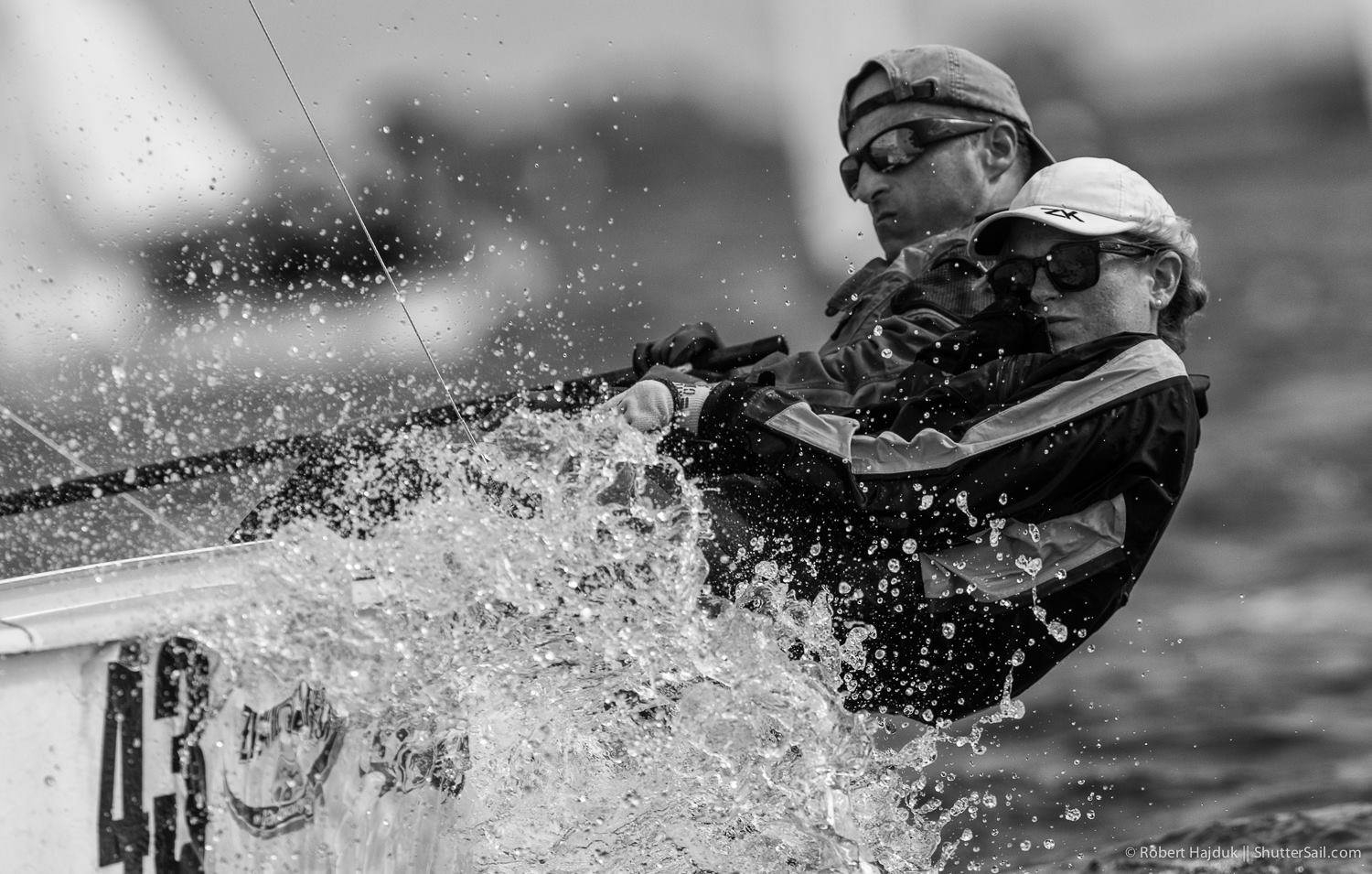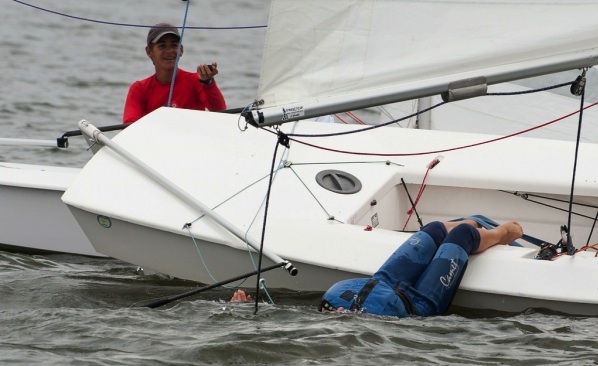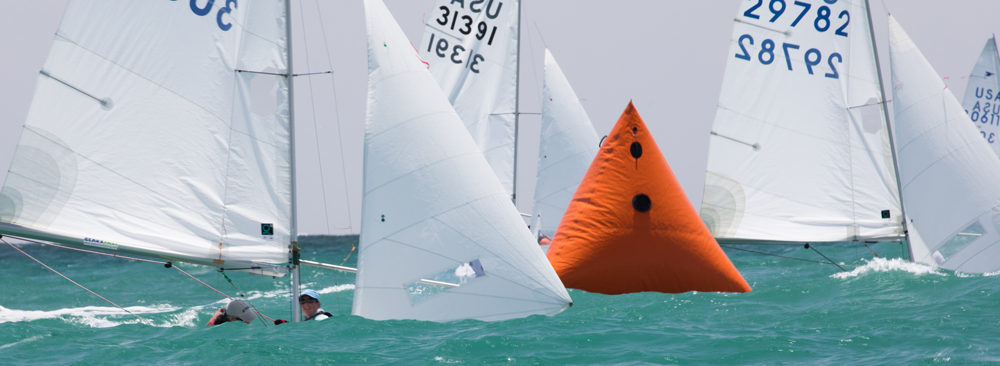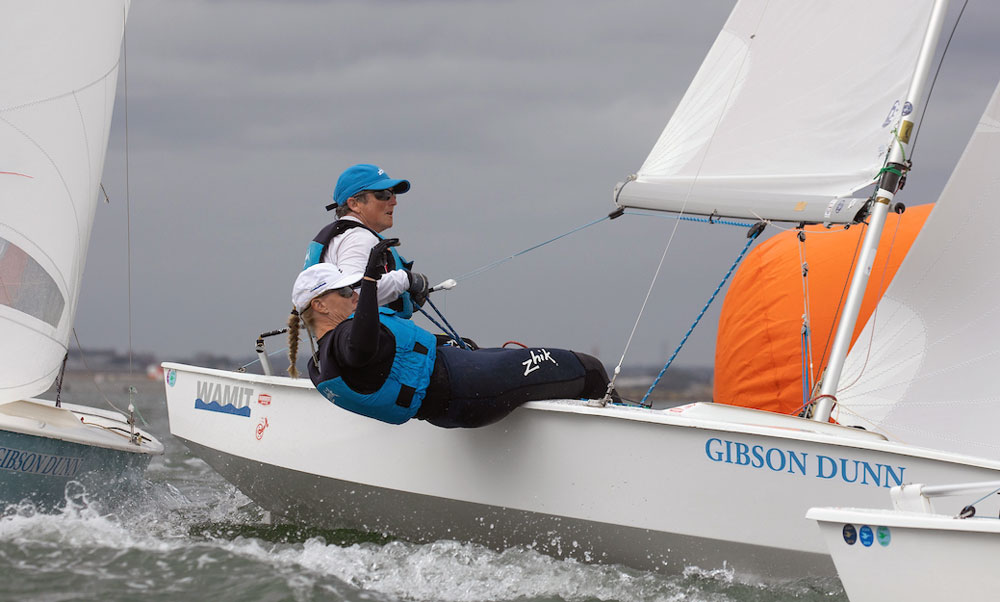The Care, Feeding, and Training of a Snipe Crew
By Pietro Fantoni I do not want to explain in this article how the maneuvers should be done and how a crew has to move in a boat. There are already excellent videos and articles written by sailors better than me. I simply want to explain what aspects it is useful to focus on if you sail with a crew who is not your usual. These suggestions can be useful whether your crew is a beginner or is already experienced. The common factor is that they sailed a little or not at all with you. 2014 was perhaps my own personal record: 15 crews for 20 regattas. (Photo courtesy of Robert Hajduk) ...


By Pietro Fantoni
I do not want to explain in this article how the maneuvers should be done and how a crew has to move in a boat. There are already excellent videos and articles written by sailors better than me.
I simply want to explain what aspects it is useful to focus on if you sail with a crew who is not your usual. These suggestions can be useful whether your crew is a beginner or is already experienced. The common factor is that they sailed a little or not at all with you.
2014 was perhaps my own personal record: 15 crews for 20 regattas.
(Photo courtesy of Robert Hajduk)
…
My detractors tell me that my temper prevents me from racing with the same crew for the whole season. I prefer to think that I attend too many races and cannot find someone who is able to follow me everywhere. In recent years I had one or two main crews with whom I had the good fortune to sail the more important regattas. This year that was impossible.
For 2015 I hope the situation will change, because of course I envy those who can train, race, improve and share victories and defeats with a single crew. It is a great advantage to race with my eyes closed, sometimes without the need to speak, already knowing what my team mate is thinking and what he or she is going to do the next second. Changing crew often is a disadvantage, especially for high-level regattas. Mutual understanding and team work are fundamental in a sport like sailing, and without them the result is often compromised.
However, I am convinced that racing with different crews is also an opportunity. It makes it possible to get to know new people and to try new ways to sail the boat. The beauty of sailing a race with new crew is that it also sharpens your own ability to adapt your style to the style of your team mate. And there are other benefits too: you will introduce new sailors to the Snipe Class, break out of your usual routine, train junior crews, and share the enthusiasm for the Snipe and for sailing with new people.
But the skipper must also be a coach. Here’s how I organize the regatta:
A few days before racing, suggest that a new Snipe crew watch some videos about maneuvers and boat handling:
Then onshore, next to the boat, you can explain the locations and uses of blocks, cleats, lines, and everything else. The Snipe is more complicated than many modern dinghies, so some lines may be unfamiliar.
If you can go out on the water the day before, or even an hour earlier than the start of the race, you will have a chance to try a few maneuvers. Focus on the most difficult maneuvers first: Tacking, jibing, and mark roundings. Practice on this is critical. In my experience, the crew will learn the best way to tack more quickly if you talk about where to put his/her feet and with which hand to pull on the old and the new sheet. This facilitate the pivoting from one side to the other. Also crucial is the timing of a roll tack. A good trick is for the crew to look and follow the timing and movements of the skipper.
For mark roundings, there is a logical sequence of things that the crew has to do (though some teams develop their own variations with a lot of time and practice). Peter Commette (Sailing Checklist) identified a long checklist for the crews.
But for one regatta with a beginner crew, it is easier to remember a short list. At the windward mark, do the big things (pole, centerboard) first; at the leeward mark, do the small things (cunningham, cloth, outhaul, mast position) first, to help you to maintain downwind speed until the last second. And of course you must be aware of the ability and experience of your crew and the strength of the wind.
For the leeward mark, I like the short list that the “Old Man”, with his crew Patti, calls “the procedure” (thank you “Old Man”!):
- CREW: OUTHAUL IN
- CREW: JIB CLOTH IN LIGHTLY
- CREW: POLE IN ONE FOOT
- SKIPPER: TRIM JIB SHEET
- SKIPPER: TRIM JIB HALYARD
- SKIPPER: RELEASE MAST AFT
- PAUSE TO GET CLOSER TO MARK
- AND AT SKIPPER’S COMMAND:
- BOARD DOWN AND POLE IN
- TRIM JIB AT ROUND MARK
- HELP SKIPPER TRIM MAINSHEET
Of course it is very important to keep control lines, sheets, and halyards clear in order to avoid tangles.
Keep it easy
Avoid giving your new crew too much information or too many orders. Essentiality is the key.
Before the race start, try to understand the mood of your crew, and remember that a crew (at least one that has potential to be good) will pick up on your mood as well. Being relaxed will help you both to feel the boat, and setting the right tone will hopefully keep your crew from being afraid to make mistakes or from feeling in awe.
During the race
Normally if the crew is new to the Snipe, I invite him/her to focus on the heel of the boat and on the motion through the waves. “Stay close to me, keep your shoulder in touch with mine, focus on keeping the boat at a constant heel. This is the heel I want, right now.”
Tell him/her that only an inch of ease or trim on the jib sheet makes a huge difference to the shape of the sail, especially in light wind. I usually say: “Take a visual reference both on the splash rail and on the spreader, which you can see through the window on the mainsail.”
In puffy wind, explain that the vang is also very important for boat speed, so it is fundamental not to be late in trimming or easing during a puff or a lull.
Communication during the race helps the crew and the skipper to be focused on the speed, tactics and to stay calm. With new crews, I constantly speak: “Trim an inch, hike more, vang on … vang off, go in, ease the jib”. Once the crew learns the dynamics of the boat he/she will do those things independently.
For the mark roundings, remember to steer by weight. It is also useful to talk through the sequences of the list before mark roundings.
The level of delegation
I change the way I sail depending on who I have as crew and the level of skill. If the crew has a lot of experience it’s usually specialized, and then he/she can contribute to your success in that area. This year I sailed with the crew-sailmakers, who constantly and perfectly trimmed the sails; with crew-tacticians, in which case I focused on sailing the boat fast and they told me where to start, where to go, when tack and jibe; and also with crews who shared every decision around the course. It is important, useful and exciting to race with people who will help you learn different aspects of sailboat racing than you might normally focus on yourself.
What should not be forgotten, though, in any case, is that there must be a level of delegation (however small). Even the inexperienced crew must be empowered. For example, in light air, a beginner may provide information about where he or she sees more wind, about the heading of the other boats, and any upcoming crossings with other boats, especially close to the marks.
What if the crew makes a mistake? (The classic example is when the pole launcher line is tangled and the crew cannot trim the jib sheet at the bottom mark.)
First, do not get angry. It is easier to say than to do, and you may have helped cause the problem (if only through a lack of preparation/instruction). Second, minimize the loss, solving the problem as quickly as possible. While your crew tries to untie the knot hike as hard as you can, trim the main, and sail the boat as best you can. Third, try to prevent recurrence of the problem: often the error depends on the skipper who did not follow the timing of the crew or simply did not check that all the lines were clear. Fourth, consider adjusting your mark rounding tactics to fit the experience of your team; it makes no sense to try to get a last minute inside overlap at the leeward mark if the crew is not going to get the pole down in time. Minimizing boathandling errors requires giving enough time to the crew.
Temperament: some crew (and some skippers) have to be motivated; others have to be calmed down. Everyone on the boat has to be a psychologist of the other. You have to understand each other. It isn’t a coincidence that my best crews are also my best friends.
One last tip: avoid focusing too much on what your crew is doing. You have to look at what happens in front of you, but do not forget to do your own job well. Think about what you are doing and try to do your best, without letting a new crew be too much of a distraction.
Pietro Fantoni
P.S.
I want to thank my crews in 2014 : Giovanni Stella, Alan Capellin, Giovanna Gangitano, Alberto Cassandro, Kathleen Tocke, Marinella Gorgatto, Stefano Selleri, Alberto de Paoli, Eleonora Zuzic, Tullio Nutta, Julia Melton, Jane Alquati, Michele Meotto, Alizee Del Gizzo, Arianna Buzzetti.
The crew is a friend with whom to share an adventure, a trip, a regatta. Our finish position depends on so many variables, some outside our own control … What matters is that we did our best and we had fun. And also I have learned so much from all of you.
Leave a reply
Your email address will not be published. Your comment will be revised by the site if needed.






0 comments